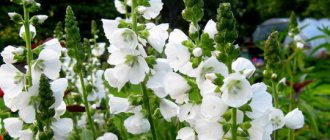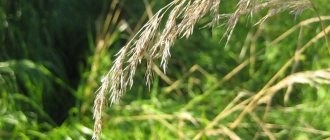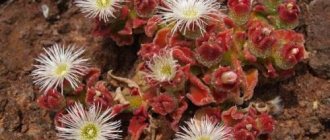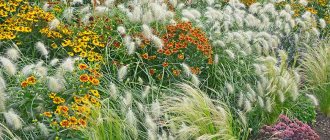Photo: oir.mobi Although decorative lupine is a legume, in some areas it is valued primarily as a beautiful flower. Tall and voluminous multi-colored brushes against a background of dense foliage look great in group plantings. Lupine is also an ideal natural green manure that can fertilize the soil itself and repel insects. Interested? Let's talk!
Origin, description of the flower
The lupine plant belongs to the legume family. Species diversity contains perennial and annual variations. A popular garden flower is a lush bush with tall, bright inflorescences.
Lupine is popularly called “wolf bean”. In nature, the plant is widespread on the American continents, and also grows in some areas of the Mediterranean and Africa.
Lupines tolerate drought well, so they often grow in deserts. Numerous hybrids are used in floriculture, which were created in the 20th century by Russell.
Collecting seeds
Lupine seeds, cracking, scatter around the mother bush, so the beans are collected as soon as they begin to dry out on the shoot. Then they are dried completely spread out on a table in the shade in a well-ventilated place. The seeds are collected in stages, since the drying beans from below can be ready for harvesting, and those located higher on the arrow are still completely green.
After the lupins have completely finished flowering, all flower stalks are cut off; if necessary, the seeds are collected - the rest is thrown away. If there are bare stems of plants, then they are hilled up and then covered with leaves or sawdust for the winter so that the plants do not freeze in cold weather if frosts hit the ground without snow cover.
Conditions required for growing
Growing lupins is not difficult. It is easy to provide suitable conditions for a flower. Any gardener can cope with the task. Lupine loves bright sunlight. It is better to place it in open areas. He is not afraid of direct rays of the sun, as well as drought. Any soil is suitable for planting.
The flower responds most gratefully to loamy soils. Neutral, slightly acidic or slightly alkaline compositions are acceptable. Hybrids used in floriculture feel good in the natural environment of the middle zone. They do not need to provide additional special conditions.
Planting seeds in open ground
It is often not possible to grow luxurious flowers from purchased seeds: the germination rate is not always good. If a florist has been breeding lupins for several years, then it is advisable to collect the beans at their summer cottage and use them for breeding a spectacular species.
Deadlines
There are two methods:
- autumn planting of seeds. In this case, the planting material overwinters in the ground, produces good seedlings in the spring, and original pyramidal inflorescences appear in the summer (around July);
- planting seeds in spring. The method is used more often. The optimal time is mid-April. With sufficient heat and moisture, luxurious flowering can be observed as early as June.
Selecting a location
On a note:
- For planting plants with pyramidal inflorescences of bright and delicate shades, an area with diffused lighting and a minimal amount of shadow is suitable. The scorching sun negatively affects flowers, but a lack of lighting does more harm.
- Lupines are not planted in shaded places or under trees: without sufficient light, the inflorescences are small, inconspicuous, the bushes are weak, the flowering period is short or does not occur at all.
- The site should not be in a lowland: lupine does not like excess moisture that accumulates after rain.
Landing rules
Important details:
- suitable soil is an alkaline loamy or slightly acidic substrate. Diseases develop more often in an alkaline environment. It is useful to add peat or add a little acidic solution;
- adding lime flour is an important stage in preparing the soil for planting plants with tall, lush inflorescences. For 1 sq. m, 5 kg of bulk product is enough. Lime flour is applied in autumn, winter (on snow) or in spring, while digging the soil;
- Frequent loosening is not required: the root system actively pushes the road deeper, and the soil becomes softer.
Interesting fact! Lupine enriches the soil through the development of nitrogen-fixing microorganisms on the roots of the plant. The process is most active on blue lupins.
Features of flower care
It is important to understand how to water lupine. It does not need abundant irrigation. A sufficient amount of moisture is provided after planting, as well as during the beginning of the growing season. The rest of the time, periodic moderate hydration is acceptable. The flower is able to withstand a lack of moisture.
To maintain optimal external characteristics, it is better to avoid drought. The flower also does not require abundant fertilizer.
It is recommended to additionally feed the plant only in the second year of life. The soil is enriched with fertilizer once in the spring. They use a complex composition based on minerals without nitrogen content.
Feeding and fertilizing lupine
In the second year of life, lupine needs feeding. Before flowering begins, you can apply the following fertilizers:
- superphosphate and potassium chloride 2:1 per 1 m2;
- a few spoons of ash under each bush;
- organic fertilizers;
- on sandy soils, fertilizing with magnesium or dolomite flour is necessary.
To make the plant bloom more actively, feed it
Advice. Be careful with nitrogen mineral fertilizers: high doses of nitrogen negatively affect the growth of lupine, especially yellow and narrow-leaved ones.
Subtleties of planting
Lupines are planted using seeds. This can be done by first planting the seedlings. In this case, sowing is carried out in early spring.
Shoots will appear faster if you add crushed old lupine tubers to a mixture of turf soil, peat and sand. They will act as a kind of fertilizer and will help nitrogen-containing bacteria, which are in symbiosis with the plant, to adapt more quickly. After germination, wait until 2–3 true leaves form.
Only in this state are seedlings moved into open ground. Lupine seeds can be sown immediately in a permanent place. This is done in the fall at the end of the growing season or in April.
What are the structural features of lupine?
It differs in the shape of the root system; it is presented in rod form and is capable of going deep into the ground up to two meters. Small swellings can be found on the roots, allowing them to absorb the necessary amounts of nitrogen in the air.
Subsequently, the soil under the flower is enriched with nitrogen. The stems are presented in a woody or herbaceous version, and also come in creeping, protruding and even erect variations.
The leaves are distinguished by an alternate arrangement and are attached to long petioles. They belong to the palmate-compound species, fixed to the stem with the help of a leaf cushion system and an extended stipule.
Lupine is distinguished by a large number of flowers in each inflorescence, they are arranged in different ways. Some plant species have a brush up to one meter in size. The color pleases with an unprecedented variety of playful color shades present.
Lupine has seeds that differ in shape, size and even color. Species from the Mediterranean are distinguished by their larger forms in comparison with their American relatives. The seeds are found in the beans of this plant; when they dry, a copious amount of seeds are thrown out.
Lupine is often used to decorate flower beds, but it also has other uses. It is grown as a green manure to fertilize depleted soil. And there are also species used as animal feed. It is usually fed to rabbits.
Diseases and pests
Lupine is not demanding on conditions and care, but can be attacked by harmful insects. During the period of bud formation, aphids run the risk of settling on the plant. For timely assistance to the flower, regular inspection of the plantings is necessary.
In summer, the plant can be attacked by the nodule weevil. Sprout fly larvae can also cause damage. You can get rid of parasites only by treating the bushes with special compounds.
Lupine is susceptible to a number of diseases:
- fusarium wilt;
- root and gray rot;
- Phomopsis;
- rust;
- viral mosaic.
To prevent infection, it is important to follow the rules of agricultural technology. Seedlings of an annual plant are not placed in one place. Lupine will be healthiest where cereal crops were previously grown. You can return the flowers to their original place no earlier than after 3 years.
Perennial species and varieties do not survive for more than five years. Over time, the middle of the bush dies, ruining the aesthetics of the plant. The bush is dug up and young lupine is planted next season.
Reproduction methods
Annual lupine always reproduces by seeds, and perennial lupine by seeds and vegetatively.
Seeds can be sown directly into the ground both in the fall (late October) and spring (in April). Autumn sowing is most suitable for varieties that can reproduce by self-sowing and are quite frost-resistant. In this case, flowering will begin in August. And seeds sown in early April will bloom the next year at the end of May.
In March, flower seeds are sown for seedlings. And after about 20-40 days, when the first strong leaves appear, they are transplanted directly into the flowerbed.
The core structure of the lupine root system makes it intolerant to transplantation. Therefore, it cannot be propagated by dividing the bush.
The vegetative method of propagation of perennial species involves cuttings. In the spring, the newly formed basal rosettes with growth buds are taken as cuttings (they are carefully cut off from the root collar), and in the summer, young side shoots are used for this, which manage to form in the axils of the leaves. They are rooted in a shaded place, adding sand to the soil. After about a month, the young plants will take root and can be transplanted to the chosen location.
Lupine seeds
It should also be taken into account that seed propagation can cause splitting, and young plants may turn out different from the parent ones. Hybrid varieties of perennial lupins are therefore best propagated vegetatively.
After flowering, wilted inflorescences must be cut off. This spoils the appearance, inhibits further flowering and takes extra energy from the plant to form seeds. Therefore, to collect the seeds, leave only a few dry inflorescences for ripening. Darkening and dryness of the pod is an indicator of its maturity.
Seed collection is best done in dry and sunny weather. Remove them from the pod, dry them (but not in the sun!) and store them in a glass jar with a tight-fitting lid or in a cloth or paper bag until sowing.
What to do after flowering
If lupine is grown solely to decorate the site, then it is better to cut off the fading inflorescences. In this case, the plant may bloom again. If you need to collect seeds, you need to wait until they form.
It is important not to miss the moment. When ripe, the seeds may fly out of the bean. They need to be collected before the box cracks. After the final flowering, it is advisable to prune the bush. Not only faded flower stalks are removed, but also foliage.
Perennial bushes are additionally hilled. This will help prevent exposure of the root collar, which negatively affects the plant. Before wintering, it is useful to sprinkle lupine with a layer of sawdust. This will help protect the plant from hypothermia during the cold season.
The photo of lupins shows the variety of varieties used by flower growers. Both annual and perennial variations are popular. Plants with different colored corollas are in demand. Most often this is a smooth transition of shades from white to yellow, red or blue-violet. Different varieties may bloom at different times, but always require a minimum of attention from the grower.
Varieties and varieties of lupine
Lupine is not just an ornamental plant. The seeds and aerial parts are widely used in the food industry. Decorative items are made from the stems of the plant, and lupine straw is used in the pulp and paper industry. Lupine seeds are used in the production of medical plasters, cosmetics, medications, and for the production of soap and plastics.
Lupine is not only a beautiful, but also a useful plant
Fodder lupine is grown for livestock feed, and fish farms feed fish with seeds. Lupine is the most valuable green manure crop; one hectare of lupine is equivalent to applying 20 tons of manure.
Lupins are very unpretentious plants that do not require complex care, therefore they are distributed almost everywhere, although the birthplace of this plant is North America. There are annual, biennial, perennial and fodder lupins; they are used in agriculture. Basically, annual species are used for animal feed: white, multileaf and yellow lupine.
The following annual lupins are grown as garden species:
- hybrid;
Lupine hybrid
- dwarf;
Lupine dwarf
- changeable;
Lupine is fickle
- Lupine Hartweg King.
Hartweg's Lupine King
Lupine polyfolia is a perennial. It is the most frost-resistant and undemanding in care, and is found even in the taiga.
Numerous hybrid varieties of lupins with inflorescences of various colors have been developed. Here is a list of the most popular varieties that are used in landscape design:
- Schlossfrau – pink;
Variety Schlossfrau
- Edelknabe – carmine;
Variety Edelknabe
- Burg Fraulein – white;
Variety Burg Fraulein
- Apricot – orange;
Apricot variety
- Carmineus – red;
Variety Carmineus
- Princess Julianne – white and pink;
Variety Princess Julianna
- Roseus – pink;
Variety Roseus
- Albus – white;
Variety Albus
- Rubinkönig – ruby with violet;
Variety Rubinkönig
- Castellan – blue-violet with a white sail;
Variety Castellan
- Minaret is a low-growing varietal population with brightly colored inflorescences;
Variety Minaret
- Lulu is a mixture of different colors.
The Lulu variety
is popular abroad as perennial tree lupine, which, unfortunately, does not overwinter in our latitudes.
Photos of lupins
Growing problems and ways to solve them
A flower is affected by diseases and pests if the rules for caring for it are not followed or the requirements for choosing a site are violated. The following conditions are harmful to the plant:
- sudden change in temperature;
- insufficient lighting;
- stagnation of water in the soil.
A common problem is yellowing of leaves. The reasons for this phenomenon are soil alkalinity, lack of moisture, and excess nitrogen in the soil. Liming the soil and timely watering help prevent this problem.
Sowing lupine in the early stages reduces the development of diseases
Under unfavorable conditions, diseases develop:
- Dust mold. The plant is attacked by a combination of cold and high humidity. A white coating appears on the leaves. The plant is sprayed with Topaz, Fundazol or copper sulfate.
- Gray and brown rot. It develops against the background of waterlogged soil and dense plantings. The plant begins to wither, dry out, grayish or reddish coatings appear on the leaves, and brownish spots appear. Treatment is carried out by spraying with Fitosporin, Bordeaux mixture, and copper sulfate.
- Fusario. A fungal disease that occurs during budding. The leaves begin to turn yellow, then turn brown and curl. The fungus is destroyed by spraying with Fitosporin, Baktofit.
Lupine is practically not affected by common garden pests. But some insects can settle on the plant and cause serious damage to it:
- Phytophages: wireworms, fly shoots, May beetle larvae. These pests can attack seeds immediately after sowing in open ground. To combat them, the area is treated with an insecticide before planting.
- Aphid. Attacks inflorescences during budding. If black dots are found on the peduncle, the plant is sprayed with Aktara, Actellik, Iskra, Alatar.











